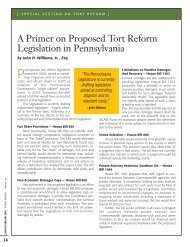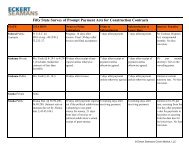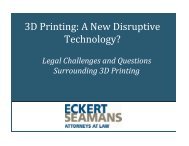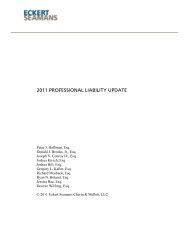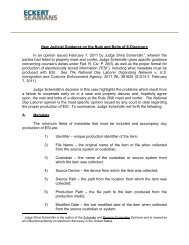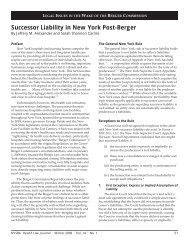§ 1303.512(b). The court, however, “may waive the requirements of this subsection for anexpert on a matter other than the standard of care if the court determines that the expert isotherwise competent to testify about medical or scientific issues by virtue of education, trainingor experience.” Id.MCARE additionally requires that an expert testifying as to another physician’s standardof care must be “substantially familiar with the applicable standard of care for the specific care atissue as of the time of the alleged breach of the standard of care.” 40 Pa. Cons. Stat. §1303.512(c)(1). The physician must also “practice in the same subspecialty as the defendantphysician or in a subspecialty which has a substantially similar standard of care for the specificcare at issue.” 40 Pa. Cons. Stat. § 1303.512(c)(2). A court, however, “may waive thisrequirement for an expert testifying on the standard of care for the diagnosis or treatment of acondition if the court determines that (1) the expert is trained in the diagnosis or treatment of thecondition, as applicable; and (2) the defendant physician provided care for that condition andsuch care was not within the physician's specialty or competence. 40 Pa. Cons. Stat. §1303.512(d). Also, “in the event the defendant physician is certified by an approved board, thephysician must be board certified by the same or a similar approved board.” 40 Pa. Cons. Stat. §1303.512(c)(3). A court, however, may waive this requirement “if the court determines that theexpert possesses sufficient training, experience and knowledge to provide the testimony as aresult of active involvement in or full-time teaching of medicine in the applicable subspecialty ora related field of medicine within the previous five-year time period.” 40 Pa. Cons. Stat. §1303.512(e). This provision was effective sixty days after March 20, 2002, which is when theMCARE Act was passed. See Bethea v. Phila. AFL-CIO Hosp. Ass’n, 871 A.2d 223 (Pa. Super.Ct. 2005) for more regarding effective date of requirements.Before the Court in Madden v. A.I. DuPont Hospital, 264 F.R.D. 209 (E.D.Pa. 2010),were two medical malpractice cases arising out of open-heart surgeries performed on infants whosubsequently died. Plaintiff Madden brought wrongful death, negligence, and lack of informedconsent actions against Defendant Physician Pizarro. Plaintiff Papacoda brought negligence andlack of informed consent claims against Defendant Physician Norwood (collectively with Dr.Pizarro “Defendants”). Plaintiffs alleged, inter alia, that had they been properly informed of therisks of an “experimental” surgery, they would not have consented. Id. at 211-212. In bothcases, Defendants filed Motions to Preclude Plaintiffs’ Expert from testifying at trial pursuant toDaubert v. Merrell Dow Pharms. Inc., 509 U.S. 579, 113 S. Ct. 2786 (1993). Id. at 211.In support of their Motions to Preclude, Defendants argued that Plaintiffs’ expert, whowas retired and stopped performing surgery approximately two years before the surgeries atissue, was not qualified to testify as an expert due to his lack of familiarity with the surgicalprocedures used by Defendants and having only, in fact, performed said surgical procedure ahandful of times during his career. Id. at 213. According to Defendants, Delaware case lawprovides that insufficient clinical experience with the procedure at issue and/or mere reliance onmedical literature constitute sufficient grounds for finding an expert unqualified. Id.The Court began its analysis of the qualifications of Plaintiffs’ expert by noting that a“liberal policy of admissibility” applies. Id. at 215 (citing Pineda v. Ford Motor Co., 520 F.3d237, 244 (3d Cir. 2008)). Additionally, the Court noted that Plaintiffs’ expert need not be the“best qualified” expert. Id. (citing Holbrook v. Lykes Bros. S.S. Co., 80 F.3d 777, 782 (3d Cir.26
1996)). The Court then noted that Plaintiffs’ expert had indeed performed the surgery at issueand that the opinions of Plaintiffs’ expert are supported by medical literature. Id. Therefore, theCourt concluded that the opinions of Plaintiffs’ expert were not based solely on subjective beliefand held that he was qualified to testify as an expert at trial.In Stimmler v. Chestnut Hill Hospital, 602 Pa. 539, 981 A.2d 145 (Pa. 2009), thePennsylvania Supreme Court held that Plaintiff’s expert reports expressed the requisite degree ofspecificity and medical certainty for a prima facie case of malpractice.By way of background, Plaintiff, after giving birth to her first child at Chestnut HillHospital in 1965, developed peripheral circulatory failure. Stimmler, 602 Pa. at 544. As part ofher medical care, Defendant Physician performed an antecubital cutdown on the inside ofPlaintiff’s right and left elbows. Id. Plaintiff was discharged but experienced complaints of painand shortness of breath for the next thirty-six years. Id. None of Plaintiff’s physicians coulddetermine the cause of her condition until an echocardiogram performed in 1999 uncovered anabnormality. Id. Subsequent echocardiograms in early 2000 revealed the presence of a twelve toeighteen inch catheter coiled in Plaintiff’s right atrium and passing into her right ventricle. Id. at544-45.Plaintiff filed a medical malpractice suit in 2001 against Chestnut Hill Hospital andnumerous physicians who had treated her in 1965. Id. In 2004, various defendants filed Motionsfor summary judgment, which were granted by the trial court. Id. at 547. In support of itsdecision to grant summary judgment, the trial court held that Plaintiff’s expert reports “failed toestablish, to a degree of medical certainty, that Plaintiff’s injuries were caused by a fragmentedcatheter left behind during the removal of catheters from cutdown procedures in May 1965.” Id.Plaintiff’s experts stated, essentially, that the 1965 procedure had the “highest likelihood” ofresulting Plaintiff’s condition and/or that the catheter fragment “must have” come from thecutdown in May 1965. Id. at 548. The Superior Court upheld the granting of summaryjudgment.The Pennsylvania Supreme Court granted Plaintiff’s Petition for Allowance of Appealand held that the trial court and Superior Court erred in granting and upholding the summaryjudgment motions. Id. at 566. In support of its decision to reverse and remand, the SupremeCourt began by noting that expert witnesses are not required to use “magic words,” rather, “thesubstance of their testimony must be examined to determine whether the expert has met therequisite standard.” Id. at 555 (citing Welsh v. Bulger, 548 Pa. 504, 698 A.2d 581, 585 (1997)).Based upon this authority, at its progeny, the Court concluded that there was sufficient evidencefor a jury to evaluate whether the catheter left in Plaintiff’s body was inserted during the May1965 procedure. Id. at 556. Moreover, the Court found that when read in their entirety,Plaintiff’s expert reports expressed the requisite degree of specificity for Plaintiff to show aprima facie cause of action. Id. at 559. Plaintiff’s witnesses concluded that a catheter used in1965 had the “highest likelihood” and was the “most likely” cause of Plaintiff’s condition. Id.The Court found that when these terms were read in the context of the respective reports, it wasclear that the experts were offering their opinions with a high degree of medical certainty. Id.27
- Page 3 and 4: EMTALA CASES ......................
- Page 5: Filing an Affidavit of Non-Involvem
- Page 8 and 9: II.PROFESSIONAL LIABILITY - AN OVER
- Page 10 and 11: The Superior Court reversed the tri
- Page 12 and 13: to a third party pursuant to the st
- Page 14 and 15: After approximately five months, De
- Page 16 and 17: learned the day after the surgery t
- Page 18 and 19: conduct to the delay in colon cance
- Page 20 and 21: court admitted the expert’s testi
- Page 22 and 23: (b)(c)other reasonable causes, incl
- Page 24 and 25: corroborated his testimony. The cou
- Page 26 and 27: husband’s estate. Plaintiff alleg
- Page 28 and 29: Other notable federal cases arising
- Page 30 and 31: The Superior Court found that in re
- Page 34 and 35: In Neidig v. United States, No. 07-
- Page 36 and 37: Additionally, the Supreme Court not
- Page 38 and 39: were not indicated for her conditio
- Page 40 and 41: surgeon is the same as it would be
- Page 42 and 43: It should be noted that the Superio
- Page 44 and 45: Finally, the court held that the tr
- Page 46 and 47: The Supreme Court of Pennsylvania r
- Page 48 and 49: nurses deviating from applicable st
- Page 50 and 51: certainty, the court reviews expert
- Page 52 and 53: Under Pennsylvania law, the Court n
- Page 54 and 55: testimony, Defendant presented his
- Page 56 and 57: Following Cooper v. Roberts, 286 A.
- Page 58 and 59: Plaintiff developed chronic diarrhe
- Page 60 and 61: where payment is made by Medicaid w
- Page 62 and 63: accomplished. In Valles v. Albert E
- Page 64 and 65: In 1980, the Pennsylvania Superior
- Page 66 and 67: Plaintiff had a routine monitoring
- Page 68 and 69: Plaintiff’s Contract ClaimsThe Co
- Page 70 and 71: is a failure to report changes in a
- Page 72 and 73: unit to assure post-surgical patien
- Page 74 and 75: sliced his wrist and arm with a raz
- Page 76 and 77: licensed professionals for whom the
- Page 78 and 79: (c)Limitations of Corporate Neglige
- Page 80 and 81: Even more recently, our Superior Co
- Page 82 and 83:
(a)HMO IssuesIn McClellan v. Health
- Page 84 and 85:
affidavit submitted by Defendants o
- Page 86 and 87:
treatments while at VA’s faciliti
- Page 88 and 89:
[s]ubstantively, we believe that a
- Page 90 and 91:
The party claiming the benefit of t
- Page 92 and 93:
deprive (him) of civil rights guara
- Page 94 and 95:
found that the District Court was w
- Page 96 and 97:
With respect to fraudulent concealm
- Page 98 and 99:
would be applied in situations wher
- Page 100 and 101:
they had not raised them in the cou
- Page 102 and 103:
(a)Informed ConsentUnder MCARE, a p
- Page 104 and 105:
civil enforcement provisions and ma
- Page 106 and 107:
MCARE also changes the manner in wh
- Page 108 and 109:
whose death, in 2005, was allegedly
- Page 110 and 111:
vicariously liable if the plaintiff
- Page 112 and 113:
health center or its equivalent or
- Page 114 and 115:
In Pennsylvania Medical Society, th
- Page 116 and 117:
to any professional who is alleged
- Page 118 and 119:
Since the 2005 amendments, there ha
- Page 120 and 121:
ule, but who intentionally ignores
- Page 122 and 123:
the original Complaint was delivere
- Page 124 and 125:
foreclose all challenges against th
- Page 126 and 127:
number of boxes), which was support
- Page 128 and 129:
questions of professional judgment
- Page 130 and 131:
deviated from any professional stan
- Page 132 and 133:
The Third Circuit affirmed the Dist
- Page 134 and 135:
claims and cross-claims remain agai
- Page 136 and 137:
By an Amendatory Order dated March
- Page 138 and 139:
The court acknowledged that there i
- Page 140 and 141:
apply and that the trial court misa
- Page 142 and 143:
Barbados had enough litigation-spec
- Page 144 and 145:
E. Preemption of Vaccine Design Def
- Page 146 and 147:
2. Pa. R. Civ. Pro. 1036.1 - Reinst
- Page 148 and 149:
Barrick, at *34-35.Furthermore, the
- Page 150 and 151:
(b) the utility of the defendant’
- Page 152 and 153:
2006). In this case, Plaintiffs bro
- Page 154 and 155:
B. Elements of a Cause of Action fo
- Page 156 and 157:
decision in Muhammad precluded Mr.
- Page 158 and 159:
considered speculative “only if t
- Page 160 and 161:
underlying cause of action involved
- Page 162 and 163:
In Capital Care Corp., the Superior
- Page 164 and 165:
The court found, however, to state
- Page 166 and 167:
of reasonable diligence. The standa
- Page 168 and 169:
not be set aside. On July 7, 2005,
- Page 170 and 171:
complete bar to recovery. Since a l
- Page 172 and 173:
On appeal, Plaintiffs claimed that
- Page 174 and 175:
In Liggon-Redding, 659 F.3d at 265,
- Page 176 and 177:
elieved of those minimum standards
- Page 178 and 179:
elevant to the proceedings, the com
- Page 180 and 181:
establish professional misconduct b
- Page 182 and 183:
Upholding the Superior Court’s Or
- Page 184 and 185:
Id.Rejecting revocation and suspens
- Page 186 and 187:
order as a sanction under Rule 4019
- Page 188:
{1009912]182




